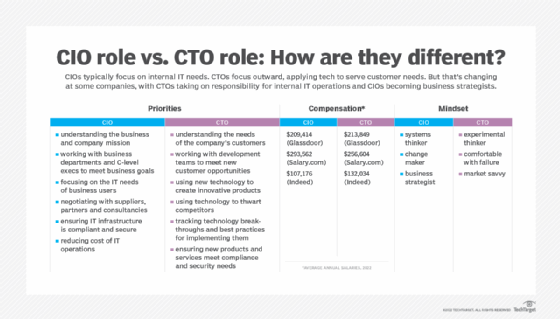CIO vs. CTO: Key differences in roles and responsibilities
The emergence of IT and its ever-increasing importance to enterprise operations led to the creation of two tech exec positions with similar duties: the CIO and the CTO.
Company leaders often used the CIO and chief technology officer titles interchangeably in the jobs' early days, sometimes arbitrarily deciding which designation to use. Although that mix-up continues to occur, the CIO and CTO jobs have -- for the most part -- become distinct.
While both roles require a strong understanding of technology, the CIO is centered on internal operations, while the CTO emphasizes external efforts, such as serving customers. Making this distinction clear is essential for enterprise organizations that employ both positions.
Here's how to further differentiate between a CIO and a CTO, plus examples of how they can collaborate to drive their company's success.
CIO vs. CTO: Differences in roles
Today, the CIO role oversees the IT ecosystem that supports an organization's operations. The person in this position is also in charge of the IT department, which manages the day-to-day work required to keep that internal IT environment running effectively and efficiently.
Meanwhile, the CTO is typically the tech executive leading a company's customer- or client-facing technology program. The person in this position is responsible for bringing tech products and services to the market.
This article is part of
The evolving CIO role: From IT operator to business strategist
Some crossover remains among the two positions, depending on whether an organization supports both positions as well as the organization's industry and its strategy.
"There is no one that says the standard definition of the job is X or Y," said Marcus H. Murph, partner and head of technology consulting at professional services firm KPMG U.S. "We have a lot of fluidity of titles with respect to tech leaders, and that's consistent with what's happening in the market and with technology and how fast technology is changing."

Responsibilities of the CIO
The CIO typically masterminds the IT that an organization needs to run its day-to-day operations. To do that, the CIO sets the IT strategy, which intertwines with the company's overall strategy. The CIO then sets the roadmap and work priorities based on the strategy.
The CIO typically owns all aspects of the IT environment and operations, Murph said. That includes overseeing the development and maintenance of employee-used applications, as well as the management of vendors that supply the company with tech products and services, such as cloud computing.
The CIO typically bases their management of the IT budget and stakeholder relationships on the IT strategy to ensure that the IT department delivers what is needed when it's needed and delivers IT projects that produce or exceed the expected returns and benefits.
"The CIO basically runs all the technology for the enterprise: application development, infrastructure, architecture, everything that keeps the company up and running," said Sal DiFranco, managing partner in the global advanced technology and CIO/CTO practices at DHR Global, an executive search and leadership consulting firm headquartered in Chicago.
Research firm Gartner summarizes the CIO duties as overseeing "the people, processes and technologies within a company's IT organization to ensure they deliver outcomes that support the goals of the business. … The CIO plays a key leadership role in the critical strategic, technical and management initiatives -- from information security and algorithms to customer experience and leveraging data -- that mitigate threats and drive business growth."
Similarly, "shaping, aligning, and delivering a unified tech strategy and vision is the biggest priority for CIOs," according to a June 2024 survey published by Deloitte.
For example, "those surveyed said that CIOs … need to exhibit a range of tech and business traits, including enabling transformation and innovation (59%), delivering topline value (57%), and serving as change agents (54%)," according to the same Deloitte survey.
Some CIOs also manage a company's cybersecurity strategy, especially in smaller organizations, DiFranco said. Those CIOs oversee the organization's cybersecurity department and might have the top security leader report to them, whether it is a chief information security officer or another title.
Some CIOs also own innovation, digital transformation, AI and customer-facing technology products and services, DiFranco said.
However, whether the CIO has those responsibilities depends on the organization's size, strategy, sector and other factors. The responsibilities also depend on whether the company employs a CTO and/or other technology-related C-level positions, such as chief digital officer, chief AI officer or chief transformation officer.
"A lot of that depends on circumstances, such as the size of the company, whether it's public or private, and the industry vertical," said Doug King, CIO at EPlus, a consulting and advisory services company headquartered in Herndon, Va. "A lot of things can drive the role and its responsibilities."
Responsibilities of the CTO
As with the CIO position, the responsibilities of a CTO can vary from one organization to the next. A job description that fits many -- if not most -- CTOs is that, typically, this role oversees the technology products and services that an organization provides to the market, such as its customers, clients and partners.
"The CTO is the top technical leader for product delivery to the market," DiFranco said.
They often have an engineering and software development background, DiFranco said.
That type of CTO is also responsible for the company's R&D, innovation and technology product strategy. The position oversees the engineering and tech product development department.
"[With this type of CTO], the CTO is very much focused on driving innovation and top-line revenue," Murph said. "The CTO is architecting the vision for the product."
The CTO position in high-tech and software companies is an exemplar of this type of CTO, Murph said. In such companies, the CTO is the executive responsible for the design, creation, delivery and success of the technology products sold by the organization.
"Traditionally, the CTO provided a single 'buck stops here' point of view on technology trends, policies and procedures critical to developing or enhancing a company's products and services," according to McKinsey & Company.
In some organizations, the person in the CTO post is responsible for the IT infrastructure that supports the company's own operations as well as the IT department that manages and maintains that IT infrastructure.
"[For that type of CTO], the CTO has taken over [tasks that] the CIO used to do," Murph said.
In such scenarios, the CTO is responsible for all technology that touches any end user and might oversee a CIO, head of infrastructure or other such title who handles application engineering, vendor management, IT architecture and the like, Murph said.
How CIOs and CTOs work together
There are many reasons why a company's CIO and CTO should work together. But some organizations don't need both.
"[There is] still a fair number of companies where there is only a CIO or CTO," Murph said.
This is particularly true among organizations worth less than $5 billion and not in the high-tech sector, Murph said.
Others have also found that most organizations employ one title or the other.
DiFranco noted that, more often than not, he works with companies with one or the other role -- but not both. Moreover, he has worked with companies that draw up nearly identical job descriptions, yet one will pick the CTO title and the other will go with CIO.
Getting an accurate count on the number of organizations that have a CIO, a CTO or both is likely impossible.
However, the Deloitte survey found that 83% of surveyed organizations had a CIO or chief digital information officer (CDIO), with 52% stating that their company had a CTO.
The figure changes significantly when considering publicly traded companies.
For example, 57% of respondents stated that they employ a CIO/CDIO, with 35% of respondents stating that they had a CTO, according to the same Deloitte survey.
In organizations with both a CIO and a CTO, they might be peers, but one could report to the other.
"The two roles must be very collaborative, and if they're not, it's a failure," DiFranco said.
The CIO and the CTO should work together to determine the most effective approach to IT-related tasks.
For example, they should collaborate to ensure that internal IT operations dovetail with customer-facing technology initiatives, DiFranco said. More specifically, they should partner to ensure that internal IT operations can successfully support external tech initiatives, even as they scale.
Furthermore, both roles should establish and manage appropriate levels of security and make sure that data flows as needed between market-facing technology products and services and the enterprise's internal IT environment, DiFranco said.
Editor's note: This article was updated in May 2025 to improve the reader experience.
Mary K. Pratt is an award-winning freelance journalist with a focus on covering enterprise IT and cybersecurity management.
George Lawton is a journalist based in London. Over the last 30 years, he has written more than 3,000 stories about computers, communications, knowledge management, business, health and other areas that interest him.






